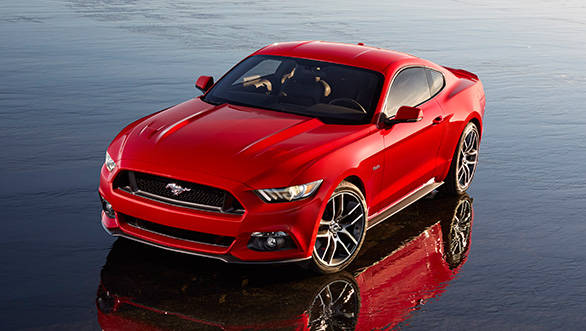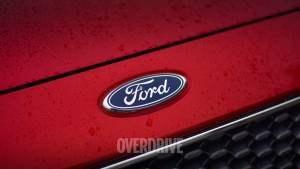Ford releases official specifications of 2015 Mustang
It's been a great month for muscle car fans. First Dodge took the wraps off the glorious 707PS Challenger Hellcat and now Ford have finally released the official specification data for the 2015 Mustang. Ford showed off their all new Mustang a few months earlier but kept the official specs under wraps until now.
 The 2015 Mustang comes with three engine options
The 2015 Mustang comes with three engine options
The Mustang will come with a choice of three engines. The range topping Mustang GT will get a 5.0-litre naturally aspirated V8 that produces 435PS and 542Nm. This considerably exceeds the 'more than 420PS' claim that Ford had earlier hinted at. The second engine is the base 3.7-litre V6 that makes 300PS and 380Nm. The power figure is actually 5PS lower than the 2014 car's but Ford has intentionally detuned the engine to make way for the new one in the Mustang range. This engine would be the new 2.3-litre EcoBoost four cylinder. This is the first time that Ford will be offering a Mustang with a turbocharged engine since the SVO came out in 1988. The EcoBoost engine generates a healthy 310PS and 433Nm.
All the Mustangs in this range will be a little heavier than the last generation. That's because Ford has ditched the archaic live axle set up in favour of independent rear suspension. That and other upgrades like bigger brakes and better interiors have driven the weight up a little across the range. However, Ford still assures enthusiasts that the Mustang will be a driver's car. Prices for the new Mustang range begin at Rs 14.72 lakh rupees in USA.
Ford releases official specifications of 2015 Mustang
| Horsepower Unleashed Motivating the All-New Ford Mustang with Improved Power-to-Weight Ratios -- 5.0-liter V8 headlines all-new Ford Mustang lineup with 435 horsepower and 400 lb.- ft. of torque and improved power-to-weight ratio -- New 2.3-liter EcoBoost® brings turbocharging and direct injection to Mustang with 310 horsepower and 320 lb.-ft. of torque best-ever power density from a Ford engine -- Manual transmission provides smoother shifting than previous Mustangs; automatic transmission features steering wheel-mounted paddle shifters and downshift rev- matching DEARBORN, Mich., July 17, 2014 The all-new 2015 Ford Mustang offers three great engines including a standard 300-horsepower V6, a brand-new 310-horsepower EcoBoost® or an upgraded 435-horsepower V8. Each powerplant is available with either a manual or automatic transmission that makes the pony car a great all-around performer no matter how the equipment is mixed and matched to suit any individual driving style. The fewer the pounds a car carries for every unit of horsepower generated by the engine, the quicker and nimbler it feels, making power-to-weight ratio a key measure of performance. A recent study by Autoblog of cars currently available in the U.S. market puts Mustang at the top of the charts in power-to-weight ratio for all three price categories a customer can specify. Mustang extends its lead further for 2015 with the EcoBoost-powered fastback now carrying fewer than 11.4 pounds per horsepower; Mustang GT has as few as 8.52 pounds per horsepower. Less is more, EcoBoost comes to Mustang The addition of a new 2.3-liter EcoBoost engine brings turbocharging to the Mustang powertrain lineup. This engine was designed specifically for Mustang, to meet the needs of drivers looking for outstanding performance and fuel efficiency. The geometry of the EcoBoost intake manifold and turbocharger housing has been optimized to provide better breathing and higher output in Mustang. Producing 310 horsepower and 320 lb.- ft. of torque, the 2.3-liter EcoBoost engine fits the bill for a true Mustang powerplant with the highest power density yet from a Ford engine. "This EcoBoost engine delivers the healthy output Mustang drivers expect, regardless of the car's speed," said Scott Makowski, EcoBoost powertrain engineering manager. "It delivers where a Mustang driver expects it to with a broad, flat torque curve and great driveability under any conditions." The newest member of Ford's global EcoBoost engine family, the 2.3-liter continues to take advantage of state-of-the-art technologies including direct fuel injection, twin independent variable camshaft timing and turbocharging to produce big-engine power and torque with improved fuel efficiency. The 2.3-liter EcoBoost is the first Ford engine to use a low-inertia twin-scroll turbocharger that provides quicker boost response while enabling lower emissions and improved efficiency. The cylinder head features an integrated exhaust manifold that separates the inner and outer pairs of cylinders into each of the two inlet passages to the turbo. Keeping the exhaust pulses separated from the next cylinder in the firing order virtually eliminates mixing losses and maximizes the pulse energy to the turbine wheel. The result is similar performance to a more complex twin-turbocharger configuration, meaning quicker turbine spin-up and torque delivery when the driver needs it for passing maneuvers. The separated exhaust ports also enable the exhaust valves to stay open longer for reduced pumping losses that improve specific fuel consumption compared to a single-scroll turbocharger configuration. With a compact mill generating nearly 135 horsepower per liter and more than 139 lb.-ft. of torque per liter powering a performance car whose drivers are more inclined to use it ensuring engine durability was critical. Enhancements to the Mustang EcoBoost engine to withstand the added stresses include: -- Forged-steel crankshaft -- Piston-cooling jets -- Steel piston ring carriers -- Premium bearing materials -- Upgraded valve seat materials -- Forged-steel connecting rods -- High-pressure die-cast aluminum cylinder block with ladder-frame bearing caps -- Deep-sump, die-cast aluminum oil pan The beating heart of a pony No Ford Mustang engine lineup would be complete without a great V8 engine at its core. The 5.0-liter V8 powers into a new generation with a host of upgrades that help it breathe better, especially at higher engine speeds. Many of these changes are derived from lessons learned in developing the special-edition 2012 Mustang Boss 302. Getting air into the cylinders and exhaust out is key to generating more power and torque from any engine. That has been the focus in the development of this V8, which features: -- Larger intake valves -- Larger exhaust valves -- Revised intake camshafts -- Revised exhaust camshafts -- Stiffer valve springs ensure valves close completely at high rpm -- New cylinder head casting revised ports provide straighter path to the valves for less restrictive intake and exhaust flow; combustion chamber modifications accommodate larger valves -- Sinter forged connecting rods are lighter and more durable for high-rpm operation -- Redesigned piston tops deeper cutouts clear the new larger valves -- Rebalanced forged crankshaft to support higher-rpm operation These upgrades have boosted output of the V8 to 435 horsepower and 400 lb.-ft. of torque. A new intake manifold includes charge motion control valves to partially close off port flow at lower engine speeds. This increases the air charge tumble and swirl for improved air-fuel mixing, resulting in better fuel economy, improved idle stability and lower emissions. The variable camshaft timing on the intake side now has a greater range of adjustment available thanks to mid-lock phasers. This enables better optimized control of the valve timing over a broader range of engine speeds and loads for improved fuel economy and emissions. Shifting gears More than most drivers, Mustang owners like to take control and shift for themselves. Whether they select a fully manual gearbox or the updated automatic transmission, the experience will be better than in any previous pony. The manual has a new shift linkage design for easier engagement and improved precision. The shift lever is now positioned closer to the driver and away from the cupholders, creating a clear path for shifting. Mustang blends outstanding all-around performance and everyday usability. Drivers who prefer to let the car handle the shifting during their daily work run, but who still want to take control when the roads get twisty, will appreciate the new steering wheel-mounted shift paddles with rev-matching downshifts now standard with the SelectShift® six-speed automatic transmission. The automatic also features a redesigned case with cast-in ribs that help make it stiffer and reduce weight. Internally, clutches are optimized and operating temperature increased to reduce friction. The output shaft is now supported by a ball bearing that enables a top speed of 155 mph for Mustang GT. With a choice of powertrains to suit driving preferences and lifestyles, the new Mustang has cutting-edge technology under the hood to match its modern design. Yet regardless of engine choice, the car remains quintessentially Mustang. | |
Starts Rs 74.62 Lakhs
4951cc
Automatic
401
515
-NA-












